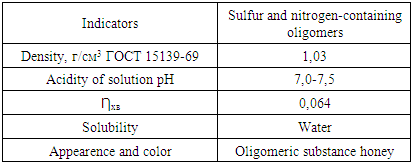-
Paper Information
- Paper Submission
-
Journal Information
- About This Journal
- Editorial Board
- Current Issue
- Archive
- Author Guidelines
- Contact Us
International Journal of Materials and Chemistry
p-ISSN: 2166-5346 e-ISSN: 2166-5354
2020; 10(1): 5-7
doi:10.5923/j.ijmc.20201001.02
Received: Aug. 16, 2020; Accepted: Sep. 10, 2020; Published: Sep. 15, 2020

Comprehensive Protection of Wood with Compositions Based on Nitrogen and Sulfur-Containing Oligomeric Compounds
Aziza Xolboyeva1, Xayit Turayev2, Fayzulla Nurkulov3
1Doctoral Student, Termez State University, Termez, Uzbekistan
2Doctor of Chemical Sciences, Professor, Termez State University, Termez, Uzbekistan
3Doctor of Technical Sciences, Head of Technology, Tashkent Scientific Research Institute of Chemical Technology, Tashkent, Uzbekistan
Copyright © 2020 The Author(s). Published by Scientific & Academic Publishing.
This work is licensed under the Creative Commons Attribution International License (CC BY).
http://creativecommons.org/licenses/by/4.0/

Abtract The article shows the possibility of obtaining a new polyfunctional oligomer based on sulfur and nitrogen-containing compounds for the fight against termites, synthesized on the basis of local raw materials, which increases the amount of antiseptic efficiency and provides bioprotective properties. In addition to studying the physicochemical properties of the oligomers obtained, the use of aqueous solutions of organic nitrogen and sulfur oligomers prepared from local raw materials in order to increase the resistance of wood materials to termites led to positive results by 87%.
Keywords: Wooden building material, Nitrogen and sulfur-containing oligomer, Termites, Biosecurity, Synergistic effect
Cite this paper: Aziza Xolboyeva, Xayit Turayev, Fayzulla Nurkulov, Comprehensive Protection of Wood with Compositions Based on Nitrogen and Sulfur-Containing Oligomeric Compounds, International Journal of Materials and Chemistry, Vol. 10 No. 1, 2020, pp. 5-7. doi: 10.5923/j.ijmc.20201001.02.
1. Introduction
- Sulfur composite materials are special types of building materials, in the manufacture of which technical sulfur in any commercial form (powdered, liquid, lump, polymer, and other types) and or sulfur-containing waste are used as a binder (the sulfur content is not less than 30 %; with a lower sulfur content, the waste is enriched with technical sulfur) [1-3].One of the problems that wooden construction materials cause great damage to agriculture, as well as historical buildings and structures, is termites, which are being fought all over the world.Today, the damage caused by termites around the world is increasing year by year. In West Africa, termite damage to buildings accounts for 10 percent of current repair costs, while in the United States, termite damage is estimated at $ 1.5 billion a year and $ 20 billion worldwide. One family of 25,000 termites per 100 cm3 consumes an average of 50,000 cm3 of cellulose per year [2-4].Two species of termites (A. turkestanicus Jacobs, A. ahngerianus Jacobs.) belonging to the genus Anacanthotermes are widely distributed in Uzbekistan, especially in the last 20-30 years in almost all regions of the country and in the Republic of Karakalpakstan, which caused great damage to homes, agricultural buildings, and even historical monuments [2-5].Chemicals play an important role in termite control. High results can be achieved with organic substances containing sulfur and nitrogen.
2. Materials and Methods
- Sulfides of elements with valence s-electrons have a mixed ion-covalent chemical bond: covalent between sulfur atoms and ionic between metal and sulfur atoms. With a decrease in the ionization potential of these metals, the ability of sulfur atoms to form covalently bound groups with each other increases and, accordingly, the ability of metals to form a large number of polysulfide phases. Especially prone to the formation of polysulphides of metals with low first ionization potentials. Thus, sodium (ionization potential I1 = 5,14 eV) forms the following sulfides: Nа2S, Nа4S2, Nа2S2, Nа4S5, Nа2S3, Nа4S7, Nа2S4, Nа4S9, Nа2S5; as numerous sulfides formed by potassium (I1 = 4,34 eV), a smaller number of sulfides form beryllium I1 = 9,32 eV; I2 = 18,21 eV), calcium (I1 = 6,11 eV; I2 = 11,87 eV) and barium (I1 = 5,21 eV; I2 = 10,00 eV), which Have relatively higher Ionization potentials.Experimental part. New polyfunctional oligomers based on sulfur and nitrogen-containing compounds have been synthesized, with the combined introduction of which into oligomeric binders, a synergistic effect is observed.Obtaining new synthesized compositions of bioprotective additives for wood construction materials that have high antiseptic efficiency, are environmentally safe and economical is an urgent task today.Physical and chemical properties were studied: density, and the main operational and technical characteristics in bioprotective wood construction materials.Data on the physical and chemical characteristics of nitrogen-and sulfur-containing oligomeric flame retardants are presented in table.1.
|
3. Result and discussion
- As a result, an antiseptic agent was obtained, in which it was possible to improve not only the bioprotective properties, but also the most important performance indicators (table 2.). in Addition, aesthetic indicators were improved: the natural color of wood as a result of processing acquired a deeper yellowish hue.
|
 | Table 3. Biological efficiency of water solutions nitrogen and sulfur containing oligomers in relation to termites in the laboratory |
4. Conclusions
- The analysis of the work shows the prospects for the development and effectiveness of the use of composite materials nitrogen and sulfur-containing oligomers as bioprotective agents for trees of construction materials.In Uzbekistan, termite control has been highly effective in the widespread use of termites in strategic settlements.According to the results of this experiment, preventive measures against termites can lead to high economic efficiency in the future by building strong building materials.
 Abstract
Abstract Reference
Reference Full-Text PDF
Full-Text PDF Full-text HTML
Full-text HTML
